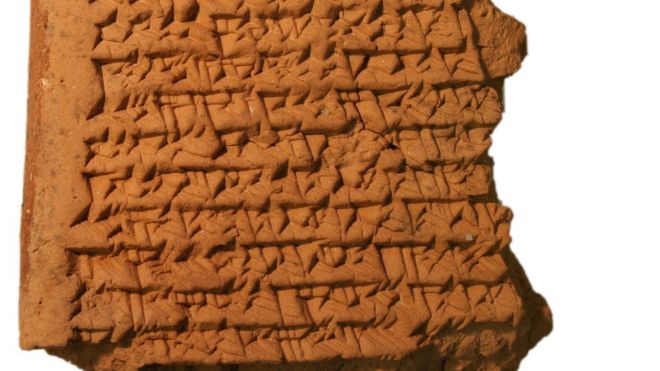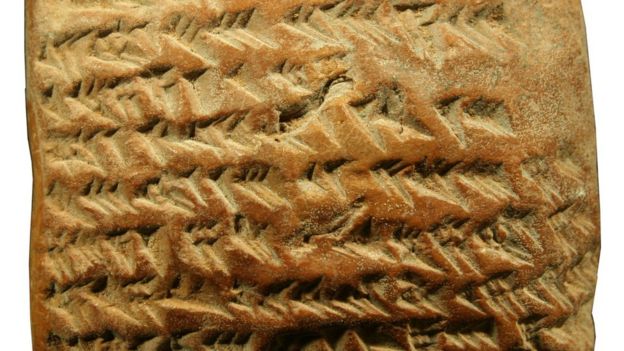世界報考古:「巴比倫人運用幾何學觀測木星」
巴比倫科學家早就可以用幾何學觀測天體。柏林洪堡大學的科學家Mathieu Ossendrijver在科學期刊"Science"上說,他們可以用幾何學估算木星的軌道。這個技術在歐洲,要到14世紀才能用算術做得到。
科學家依據的是3個知名、2個尚未公布的械板來推測,都放在大英博物館裡。這些板子年大約在西元前350至50年機。其中4片,有提到以平面方式估算木星運行軌道的圖形。
儘管沒有一塊板子提到計算方法。但是根據文本,平面計算是梯形的。
新的詮釋顯示,巴比倫的天文學家有時候會提到這些幾何運算法。」Ossendrijver說。在5塊板子上,有紀錄每天木星運行的位置及他們的軌道。類似的運算,在歐洲一直要到1400年以後才出現。
但是現在還在討論,是否巴比倫人只能計算出木星運行而已?還是可以藉由幾何學推測其他行星?「這是一位天文學家的重大發現?還是他與其他同仁一起合作的?」Ossendrijver提問。
他說現在還搞不清楚,是否他們也運用到其他行星上。現在仍無法解答,也許需要其他板子一起推論。
Ancient Babylonians 'first to use geometry'
- 3 hours ago
- Science & Environment
 Mathieu Ossendrijver
Mathieu Ossendrijver
Sophisticated geometry - the branch of mathematics that deals with shapes - was being used at least 1,400 years earlier than previously thought, a study suggests.
Research shows that the Ancient Babylonians were using geometrical calculations to track Jupiter across the night sky.
Previously, the origins of this technique had been traced to the 14th Century.
The new study is published in Science.
Its author, Prof Mathieu Ossendrijver, from the Humboldt University of Berlin, Germany, said: "I wasn't expecting this. It is completely fundamental to physics, and all branches of science use this method."
Stargazers
The Ancient Babylonians once lived in what is now Iraq and Syria. The civilisation emerged in about 1,800 BC.
Clay tablets engraved with their Cuneiform writing system have already shown these people were advanced in astronomy.
"They wrote reports about what they saw in the sky," Prof Ossendrijver told the BBC World Service's Science in Action programme.
"And they did this over a very long period of time, over centuries."
But this latest research shows they were also way ahead when it came to maths.
It had been thought that complex geometry was first used by scholars in Oxford and Paris in medieval times.
They used curves to trace the position and velocity of moving objects.
But now scientists believe the Babylonians developed this technique around 350 BC.
 Mathieu Ossendrijver
Mathieu Ossendrijver
Prof Ossendrijver examined five Babylonian tablets that were excavated in the 19th Century, and which are now held in the British Museum's archives.
The script reveals that they were using four-sided shapes, called trapezoids, to calculate when Jupiter would appear in the night sky, and also the speed and distance that it travelled.
"This figure - a rectangle with a slanted top - describes how the velocity of a planet, which is Jupiter, changes with time," he said.
"We have a figure where one axis, the horizontal side, represents time, and the other axis, the vertical side, represents velocity.
"The area of trapezoid gives you the distance travelled by Jupiter along its orbit.
"What is so special is this type of graph is unknown from antiquity - so making figures of motion in this rather abstract space of velocity against time - this is something very, very new."
He added that there was evidence that the Greeks used a "more straightforward" form of geometry, which dealt with the spatial relationships between the Earth and the planets rather than the concepts of time and velocity.
Prof Ossendrijver told the BBC that it was unclear how common this technique was.
"It could be that there was an earlier tablet, written by a genius, by one individual, who came up with this new way of doing astronomy.
"It could also be that in fact this is a method that was more widely applied by different scholars. We don't know."


沒有留言:
張貼留言